There is no denying that Manchester United Women have been one of English women’s football’s most in-form teams over recent weeks, with six consecutive wins in all competitions seeing them rise to second in the WSL and seal a place in the upcoming Continental Cup semi-finals. Plenty of players have contributed to that good run, but this tactical analysis will identify one who has perhaps gone under the radar slightly; Vilde Bøe Risa. The Norway midfielder was added to provide a balance in the central third, but has instead been transformed into an attack-minded player, operating mostly in a support role for the striker.
This scout report will examine how this change has come about during the current season, and why it has been a key factor in Manchester United’s recent success. It will also explain why it is important that Risa is kept fit during the second half of the campaign, as having her out for any period of time could harm the team’s progress and hopes of a top three finish.
Protecting the defence
As mentioned, when Vilde Bøe Risa joined from eventual Norwegian Toppserien champions Sandviken, she was initially asked to give the defence some much-needed protection, helping to shore up a back line that had conceded plenty of goals last season by helping to defend in a different way.
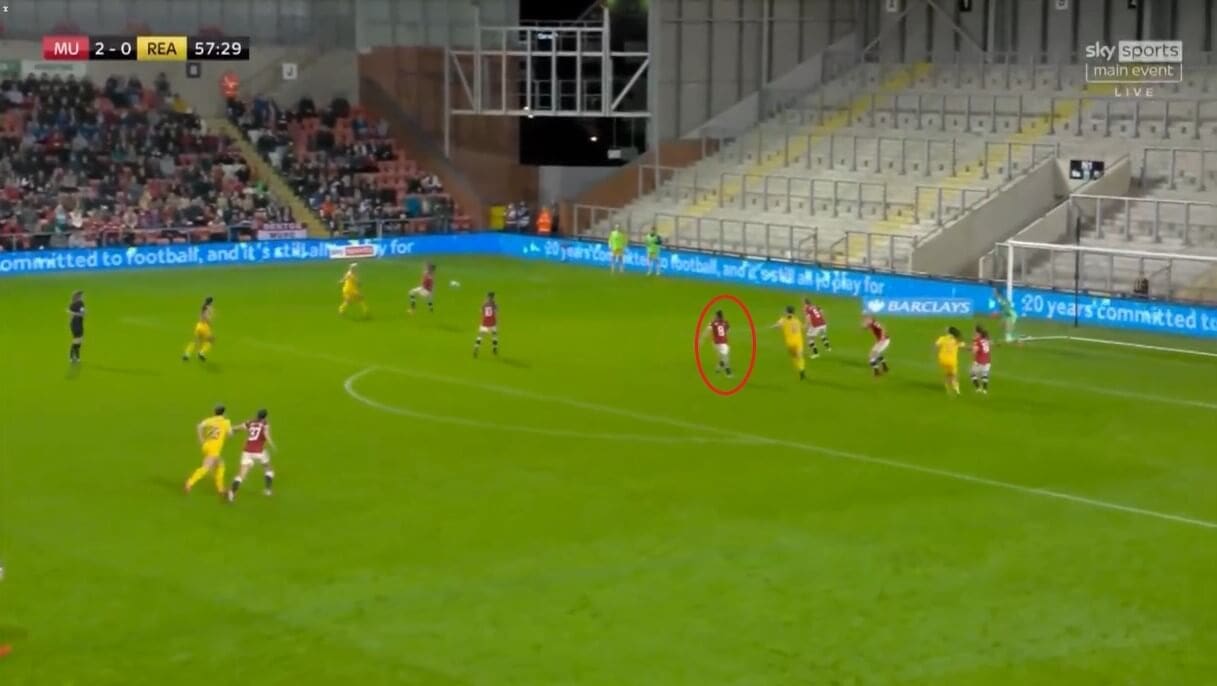
As a result, Risa stayed close to the defenders in the opening game of the season, at home to Reading Women, with her main task being to fill any holes that were left open and get her body in the way of their shots on goal. In doing so, Manchester United Women looked to make it harder for Reading to turn these offensive moves into anything more than that, which was the first sign of the new era in which they were trying to make it harder for opponents to score against them. On this occasion, Risa blocked two shots in quick succession, preventing England goalkeeper Mary Earps from being troubled, so she proved immediately capable of doing what she had been brought in to do.
Whilst Reading did struggle to get going at the beginning of the season, they still had plenty of powerful attackers available to them, including Wales internationals Natasha Harding and Rachel Rowe and former Liverpool Women and AC Milan Femmenile striker Natasha Dowie. Therefore, having a player like Risa who could prevent them creating many opportunities was important, and her average of 2.69 interceptions per game and 66.2% of defensive duels won so far highlight these defensive qualities.
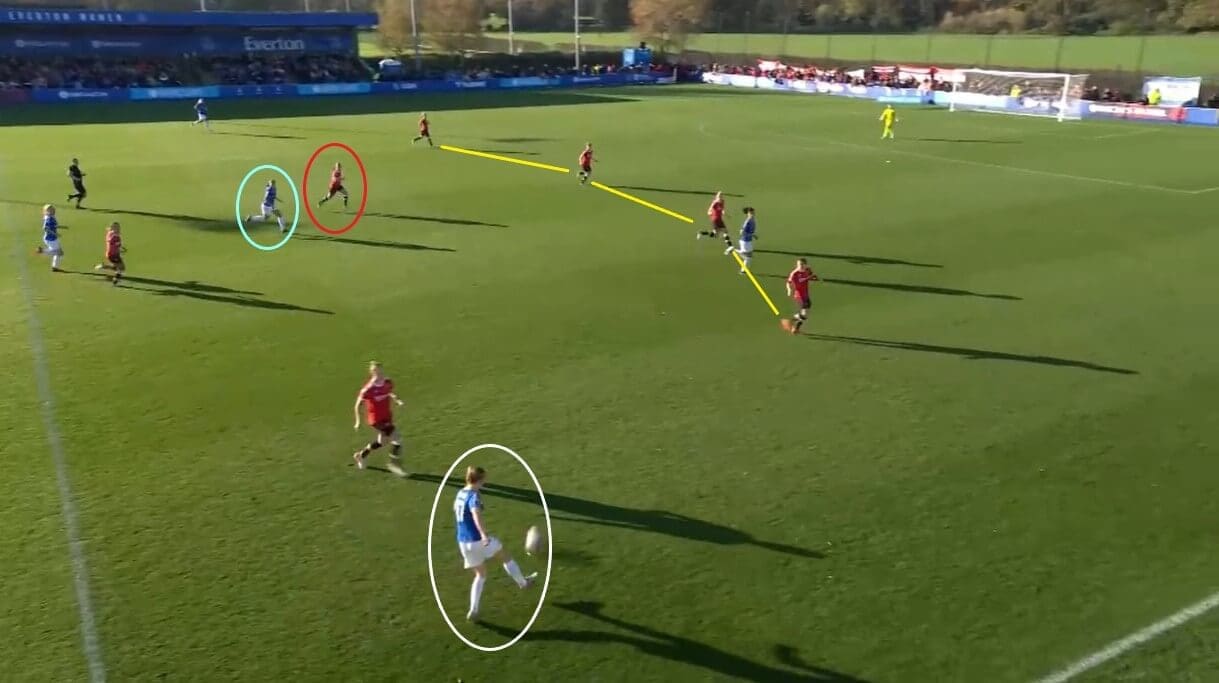
It was noticeable that Risa stayed close to the defensive line when her team were out of possession, always ensuring that they had this protection, and this again helped to make Manchester United tougher to break down than in the 2020/2021 campaign. Under former head coach Casey Stoney, now in charge of NWSL newcomers San Diego Wave, we tended to see the defenders play very high up the pitch, leaving space open behind for opponents to target with long balls, and this caused them plenty of issues. However, the reason for Stoney’s successor Marc Skinner initially positioning Risa in front of the defence was to give them some protection, as well as ensuring that they didn’t have to advance as far forwards, and this was clearly something that he had thought about with regards to how best to use the Norwegian in the team.
This image shows the positive influence that this decision had on their defensive play. Everton Women’s Scotland midfielder Lucy Graham is looking to move the ball inside the pitch, with a teammate waiting in the middle, but that player is being tracked closely by Risa, making it difficult for Everton to control the ball in this open space and look to move it forwards.
The defenders, meanwhile, can concentrate on staying together and not leaving any gaps open, rather than coming out and trying to win the ball, so having this setup has made their job easier too. In fact, it was only a defensive mistake late on that allowed Everton to score, otherwise Manchester United would have had a clean sheet, so that demonstrates how this setup has helped them to be harder to score against on the whole.
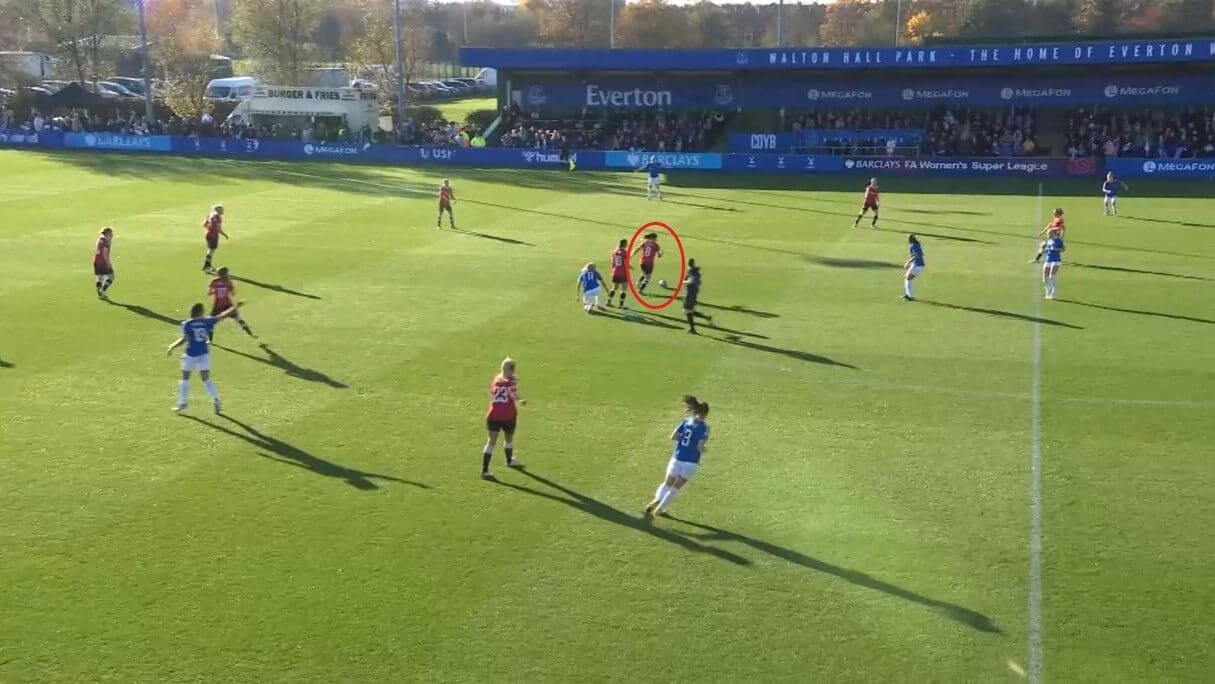
However, as the season has progressed, Risa has been given more freedom to roam further forward. Here, she has once again got tight to another of Everton’s Scotland internationals, winger Claire Emslie, forcing her into making a mistake. Once the ball has become loose, Risa turns and looks up the pitch, trying to find the best way to start an attack. Previously, she might have passed the ball and then stayed back, with her passing accuracy this season of 75.1% indicating that this is one of her strengths, but she instead moved the ball forwards herself here. With her getting into more forward areas as the games have gone on, Manchester United have had an extra body in attacking situations, giving them a better chance of creating more opportunities.
Midfield roles
As Vilde Bøe Risa has developed into a box-to-box player, she has been able to link up with teammates in different areas of the pitch, giving Manchester United Women better balance in the central third and allowing individual players to operate in their preferred roles.

This is something that can be seen clearly in this image, against Birmingham City Women, with Risa ahead of both England star Ella Toone and club captain Katie Zelem. Zelem is a player with good distribution, and is often the source of Manchester United’s attacks, so enabling her to take up slightly deeper positions allows her to see more of the pitch and find more teammates ahead of her. Manchester United’s other midfield options include Wales’ Hayley Ladd and the Netherlands’ Jackie Groenen, but both are more defensive players by trade, so Risa’s newfound attacking role again gives the team balance in the centre of the pitch and allows each player to operate where they are at their best.
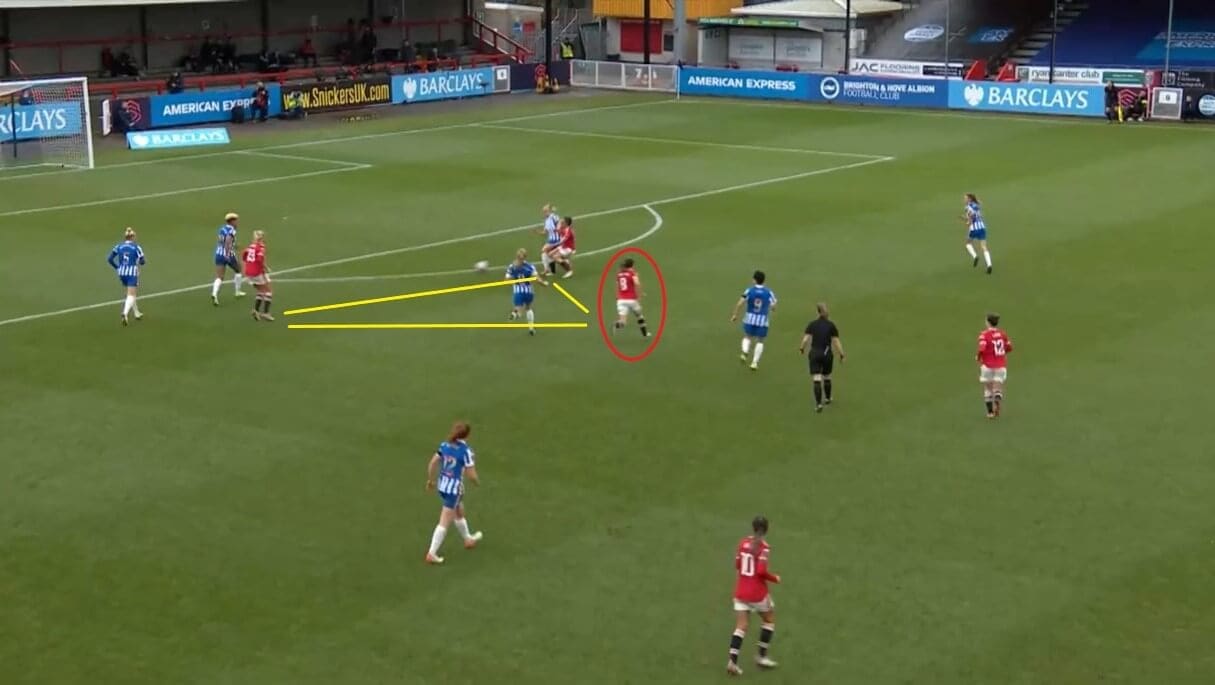
However, the player who has been affected in arguably the biggest way is Toone, as she tended to play in the hole behind the striker last season under Stoney, acting as a pivot for them to build their attacks from. This season though, we have seen her drift around much more, being deployed as a winger or even a striker at times, and this is because she doesn’t now have to think about getting into those same spaces and helping to move the ball around the pitch, giving her more freedom to cause problems for opponents in different areas of the field.
This is because Risa has taken up that role, with this image showing the Norway international in between four of her teammates and working with England internationals Lucy Staniforth and Alessia Russo to create an opportunity. This interplay does lead to a shot on goal, which misses but still tests Brighton and Hove Albion Women goalkeeper Megan Walsh, showing that Manchester United can still create chances even when Toone is not around.
Having this on-field flexibility is something else that Risa has added, and she may only have an assists per game value of 0.11, compared to Toone’s 0.37, but she has got 55.6% of her shots on target, compared to Toone’s 37%. Therefore, whilst the England player is better at creating chances, Risa is better when shooting at goal, so having her in these areas will help Manchester United to find the target on more occasions as the season goes on, keeping the pressure on those around them in the league.
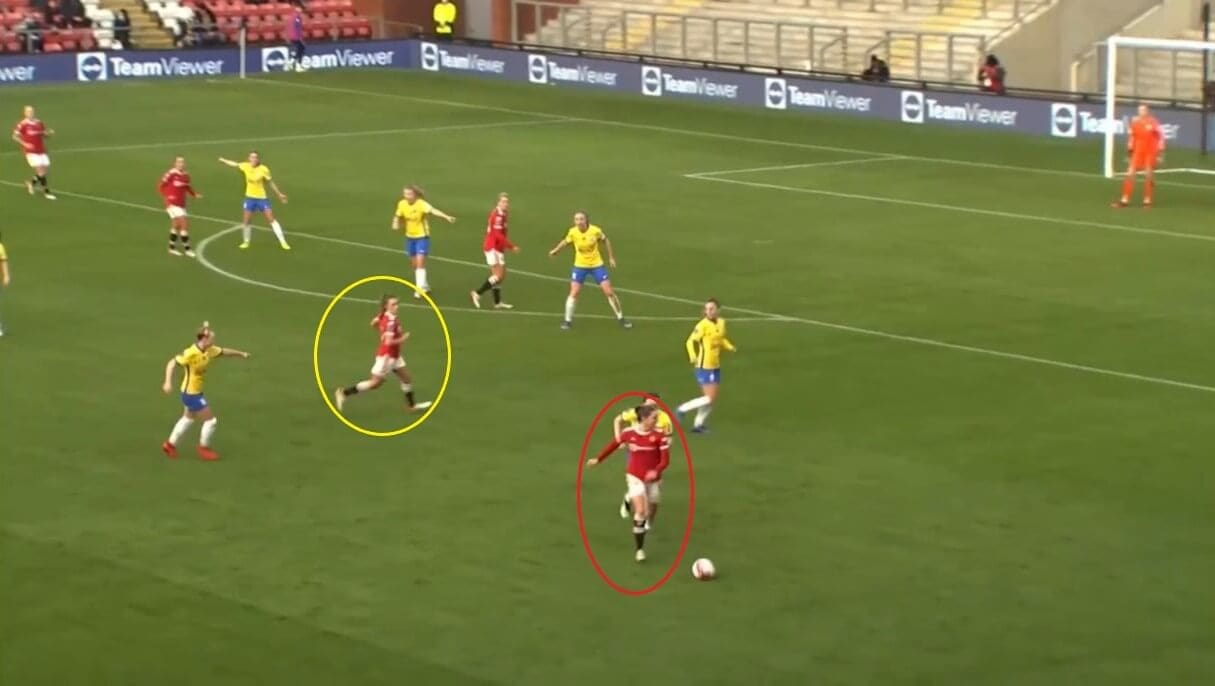
The other advantage of Risa getting into more advanced positions is that Manchester United can find ways to break through teams who defend with a low block, and Birmingham, their opponents here, are a prime example of that. The WSL strugglers have looked better since Darren Carter took over on an interim basis, following the November departure of former Glasgow City boss Scott Booth, with Arsenal Women recently unable to break them down. However, Jonas Eidevall’s side’s undoing was their lack of an alternative game plan, so they continued to try and pass their way through the defenders, making it easy to play against them.
Manchester United, however, turned to clever movement as a way of creating gaps in the Birmingham defensive line, which prevented Birmingham from remaining as rigid positionally as they had shown at St. Andrews against Arsenal, and Risa’s presence was once again a key part of these tactics. As the red circle shows, she has taken the ball away from the goal area, and a Birmingham player has been drawn towards her, which gives Toone a hole behind that she can move into.
This now gives Manchester United a viable way of moving the ball into the space behind, allowing them to create a route to goal, and it came through Risa’s initial movement. Given this, there is no doubting that she has been an excellent addition to their midfield, but what we can also see is that her teammates have improved with her around, becoming genuine Champions League contenders after finishing just outside the WSL’s top positions in previous seasons.
Supporting attacks
However, Vilde Bøe Risa doesn’t only play in an attacking midfield role; she has also been known to get even further forward and play alongside or sometimes ahead of the striker. This aspect of her play has been a big reason for Marc Skinner’s side carrying an increased threat in the final third, so it is another thing we need to consider when seeing why she has had such an impact on their recent good form.
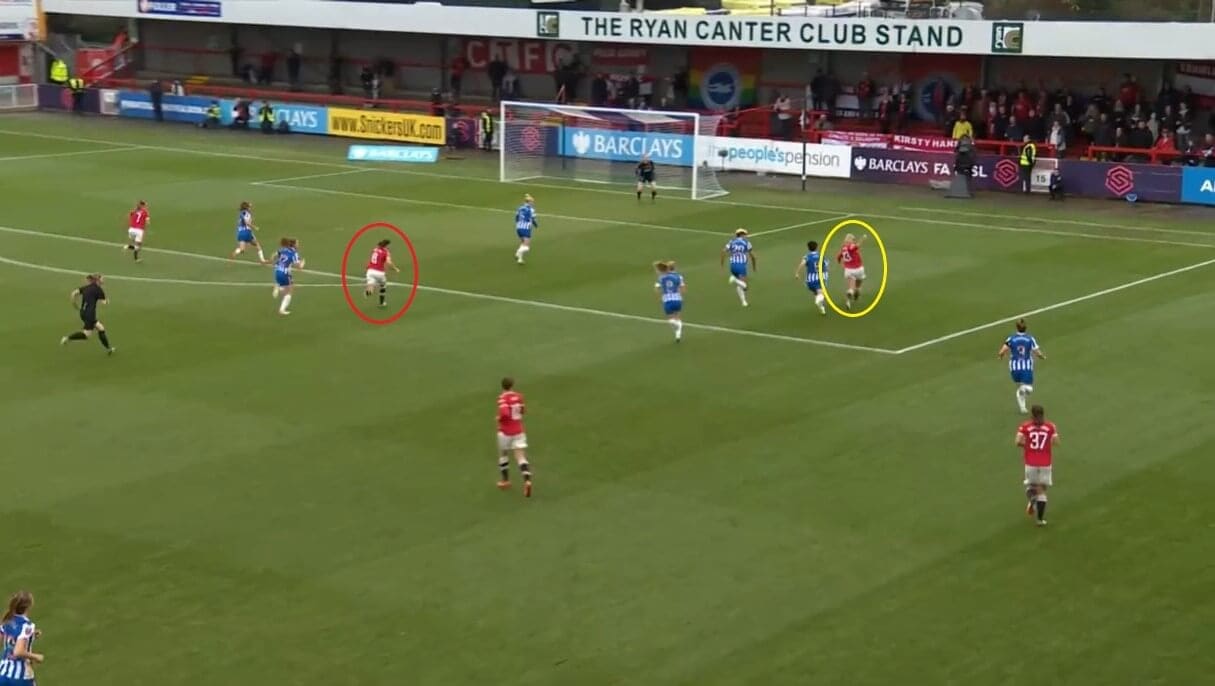
Having only Russo or ex-West Ham United Women forward Martha Thomas at the top of the field has led to a tendency for that player to drift out towards the wing, and this would normally be a problem for Manchester United Women, as the central channel would be left open. However, Risa has a good awareness of what is going on around her and ensures that this area is always filled. This is demonstrated here, with Russo on the right-hand side of the goal area and Risa in the middle, and we can see how this gives the former a way of moving the ball out of the immediate danger.
Some might point out that Toone has also made a run forward, which is correct, but she is on the far side of the box, so any attempt to pass the ball through to her would require it to travel through several Brighton players. Therefore, despite her good positioning, she is not a viable option for Russo to take, and this is why Risa’s positioning is the key detail in keeping this attack alive.
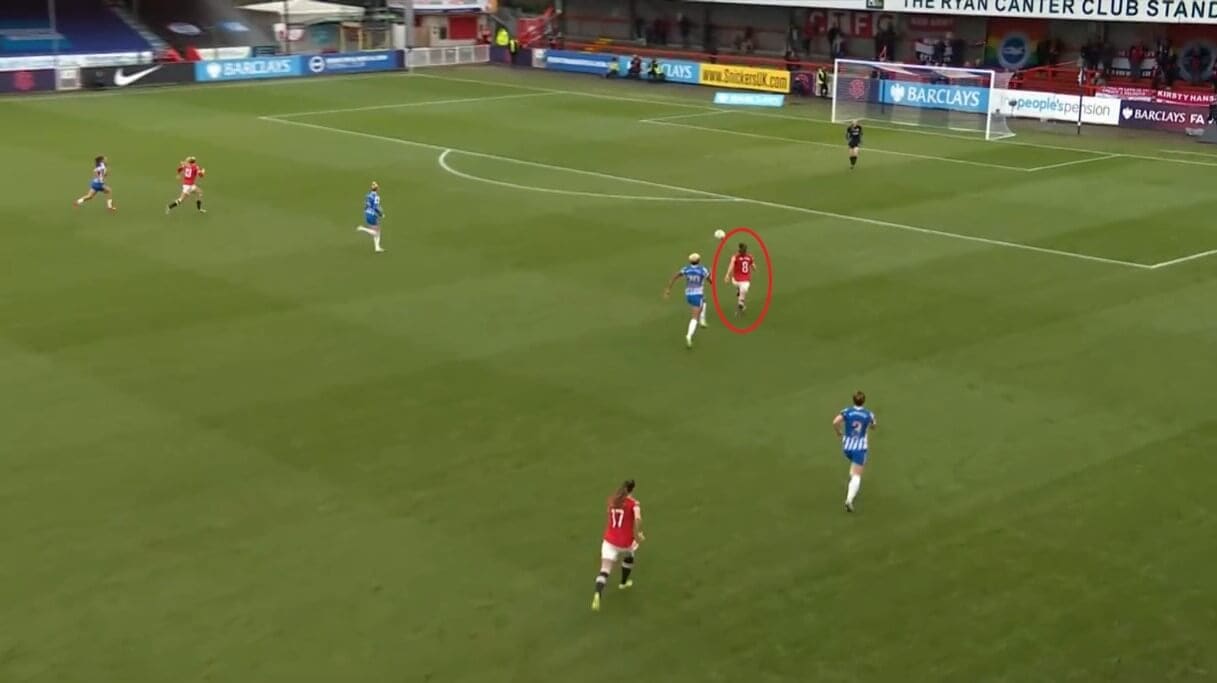
What allows Risa to access these spaces is her natural pace, and that is evident in this example too. This time, Brighton have come up the field and left the space open behind them for Manchester United to run into, with Risa obliging and getting behind defender Victoria Williams. Russo is again off to one side, so the Norway midfielder is the most likely scorer here, but she doesn’t manage to convert this opportunity into a goal. This is where she can still improve her game, as she only has a goals per game value of 0.22 (having scored twice in all competitions for Manchester United this season), whilst her expected goals (xG) value is just 0.29.
However, if she continues to get into these areas of the pitch, her confidence will grow and she will become more productive, so, despite the obvious positives so far, there is room for her to be an even better player for Manchester United in the final third if she continues to be deployed in these positions.
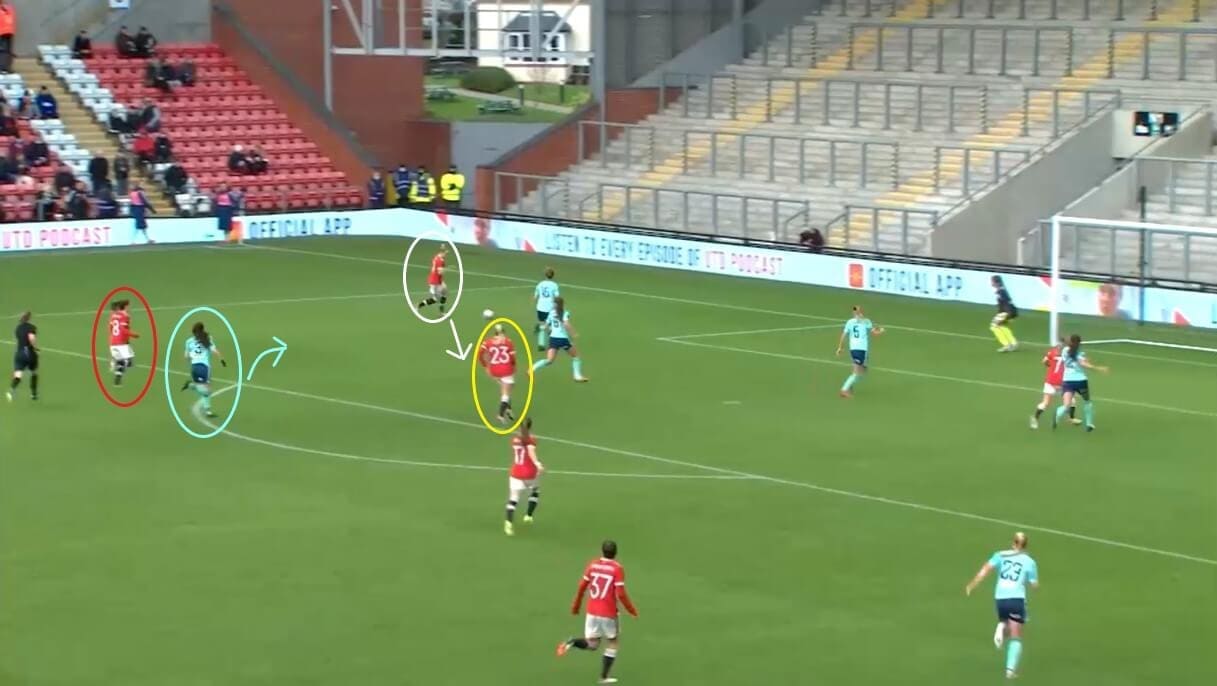
When the three forwards are ahead of her, Risa takes up a position outside the box, and she plays just as important a role here as she does when making runs in behind. In this example, she is looking to force Leicester City Women’s players into leaving a gap open, as they have packed out the goal area in their efforts to not concede here. Risa’s positioning, however, has meant that Sam Tierney’s focus has been slightly drawn towards her, leading to the Leicester player slightly arcing her run, as shown by the blue arrow.
This provides winger Leah Galton with the split second she needs to make the pass into Russo, who is in the yellow circle, and the striker gets Manchester United’s second goal of the game directly from this pass. Had Tierney not angled her run here, she may well have reached Russo before she had connected with the ball, so this is another way that Risa has been a major factor in Manchester United’s positive play this season.
Conclusion
In conclusion, this analysis has looked to find the reasons for Vilde Bøe Risa becoming such an irreplaceable player for Manchester United Women this season, and why her teammates have come to see her as one of the most important and yet most underrated players in the team. Norway head coach Martin Sjögren commented last year that she was “a balanced player with great vision”, and it is hard to disagree with that view when we consider her evolution from a defensive player to an attacking one under former Birmingham and Orlando Pride boss Marc Skinner during her still-brief time at Leigh Sports Village.
However, should Manchester United need her to drop back for a couple of games to offer some protection for the defence, she still has the qualities to do that, and it is versatility like this that makes players especially appealing for managers in the modern game.





Comments